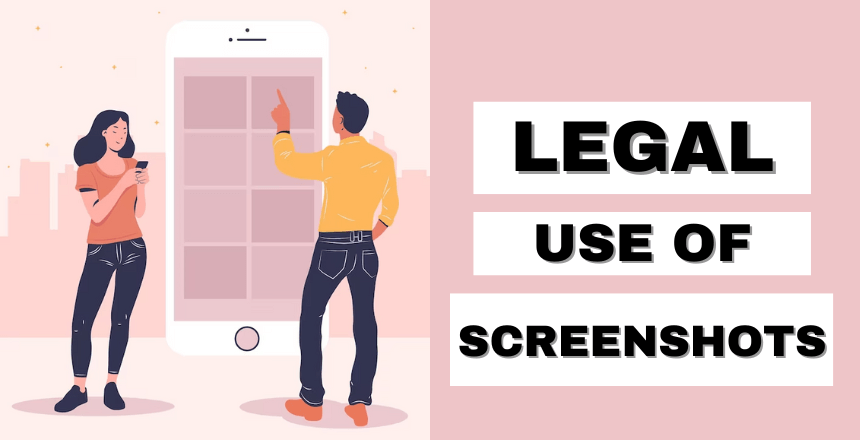In the evolving legal landscape, screenshots have assumed a pivotal role, serving as essential digital evidence.
These frozen moments in time provide a visual record of content displayed on electronic devices, rendering them invaluable in various legal scenarios.
However, comprehending the intricate web of rights, wrongs, and responsibilities tied to screenshots in the legal context is essential.
Legal Rights and Protections
In the United States, individuals are endowed with specific legal rights concerning the use of screenshots. These rights, firmly rooted in the First Amendment, safeguard the principles of freedom of speech and expression.
As a general rule, people possess the freedom to capture screenshots of public information or content they have legitimate access to.
This fundamental protection ensures that individuals can exercise their right to document and preserve digital information within the boundaries of the law.
Privacy Concerns and Wrongs
Yet, the terrain surrounding screenshots is not without pitfalls, and having the right tools can make a significant difference. One must tread carefully, particularly in matters involving privacy.
Unauthorized screenshotting of private conversations, confidential documents, or personal information using a Mac screenshot tool can lead to legal repercussions.
Instances such as revenge porn, harassment, or breaches of confidentiality highlight the gravity of respecting privacy rights. Courts have consistently ruled against those who violate an individual’s privacy through unauthorized screenshot capture.
Admissibility in Court
In legal proceedings, screenshots must meet specific criteria to be considered admissible evidence.
Authentication and Reliability
The foremost requirement is authentication. To present a screenshot as evidence, the party must establish its accuracy, demonstrating that it faithfully represents the digital content it purports to depict.
This entails proving that the screenshot has not been tampered with or manipulated in any way. Failing to authenticate a screenshot can undermine its credibility in court.
Chain of Custody
Equally critical is the establishment of a chain of custody. This meticulous documentation traces who had access to the screenshot from the moment it was captured to its presentation in court.
Maintaining a secure record of this chain is essential to vouch for the screenshot’s credibility and reliability.
Hearsay Objections
Screenshots may also face hearsay objections. Hearsay refers to an out-of-court statement presented in court for the truth of its content.
Courts often scrutinize screenshots to determine whether they qualify as hearsay. While some exceptions may permit the admission of screenshots as non-hearsay evidence, such as statements against interest, it remains a consideration in legal proceedings.
Responsibilities of Parties Involved
Duty to Preserve Evidence
All parties involved in legal matters bear a responsibility to preserve relevant evidence, including screenshots.
Neglecting this duty can result in spoliation claims, with potentially severe consequences for the party responsible. Thus, proper documentation and preservation of screenshot evidence are essential.
Obtaining Consent
Prudence dictates that individuals and organizations should seek consent when capturing potentially sensitive information through screenshots.
This becomes especially crucial when dealing with communications that involve personal or confidential details. Respecting the privacy and rights of others is an ethical imperative.
Legal Consultation
In complex legal cases involving screenshots, seeking legal counsel is advisable. Attorneys specializing in digital evidence can provide invaluable guidance on collecting, preserving, and presenting screenshot evidence in court.
Their expertise helps navigate the intricacies of the legal landscape, ensuring that evidence is handled appropriately and potential pitfalls are avoided.
Ethical Considerations
Responsible Use
While legality defines what can be done, ethics govern what should be done. Responsible screenshot use hinges on exercising discretion and respecting the privacy and rights of others.
Operating within the bounds of legality does not absolve individuals from their ethical obligations to act responsibly.
Avoiding Manipulation
Ethical conduct extends to refraining from manipulating or altering screenshots to misrepresent facts.
Such actions not only compromise the integrity of the legal process but can also lead to ethical violations and potential legal consequences. Upholding ethical standards is paramount in all matters involving screenshots in the legal arena.
Practical Tips for Handling Screenshots in Legal Matters
Navigating the practical aspects of handling screenshots in legal matters requires careful consideration and adherence to best practices. These tips can help ensure the integrity and admissibility of screenshot evidence:
Time-Stamping and Metadata Preservation
When collecting screenshots for potential legal use, maintaining evidence integrity is paramount. Time-stamping screenshots provide a valuable reference, establishing when the screenshot was taken.
Additionally, preserving metadata, which includes details about the device, application, and time of capture, can further authenticate the evidence, reinforcing its reliability in court.
Secure Storage
Ensuring the secure storage of screenshot evidence is crucial. Protection against accidental deletion, data corruption, or unauthorized access is paramount.
Employing secure storage solutions, such as cloud-based platforms with robust encryption or external drives, safeguards the evidence, guaranteeing its availability when needed during legal proceedings.
Legal Jurisdiction Awareness
Legal standards and requirements can vary significantly across jurisdictions. What may be admissible evidence in one jurisdiction may not hold the same status in another.
Therefore, it’s imperative to stay well-informed about the specific legal standards and practices applicable to your location or the jurisdiction where your legal matter is being addressed.
This awareness is vital to ensure the admissibility and reliability of screenshot evidence.
Expert Witness Testimony
In cases where the authenticity or reliability of screenshots is disputed, expert witness testimony can be invaluable.
Digital Forensic Experts
Digital forensic experts possess specialized knowledge and tools to conduct comprehensive analyses of screenshots.
They can assess the integrity of the evidence and provide expert testimony in court regarding their findings. Their involvement can significantly strengthen the credibility of screenshot evidence.
Documenting the Collection Process
Expert witnesses can also play an essential role in documenting the collection process of screenshots.
By meticulously recording the procedures followed, these experts help establish the legitimacy of the evidence. This documented process can further enhance the evidence’s admissibility in court.









